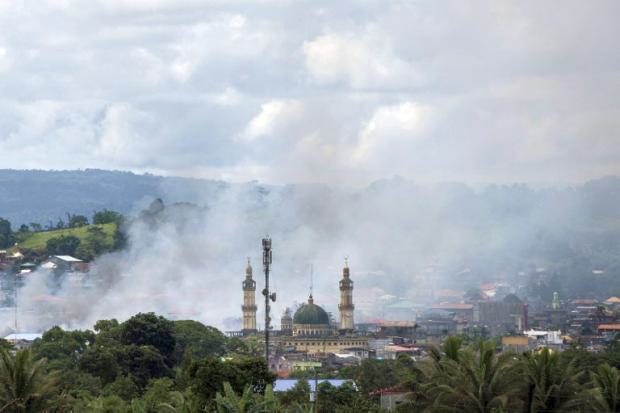
Smoke rises after aerial bombings by Philippine Air Force planes on Islamist militant positions in Marawi in Lanao del Sur in Mindanao on June 6, 2017. With bomb-proof tunnels, anti-tank weapons hidden in mosques, human shields and a “mastery” of the terrain, Islamist militants holed up in a southern Philippine city are proving a far tougher opponent than military chiefs expected. (Photo by NOEL CELIS / AFP )
MARAWI CITY – Maranao civil society leaders are seeking a dialogue with President Rodrigo Duterte regarding the ongoing siege by Islamic State-inspired militants on Marawi City in the hope of “offering alternative views” on how it can be ended.
“Mr. President, we appeal to you to give us time to present our case,” said Maranao woman leader Samira Gutoc-Tomawis, spokesperson for the Ranao Rescue Team.
Tomawis was one of 10 government nominees whom Duterte appointed to the 21-member Bangsamoro Transition Commission. She resigned from the body partly in protest to the carrying out of air strikes on entrenched positions of militants, wreaking massive devastation on the historic city.
“There are things that we want to tell you directly, Mr. President, not through anybody,” Tomawis said.
Tomawis refused to divulge what these things were but quipped: “We humbly offer what we observed, what we gathered about the siege.”
“This is a complex problem. Primarily, we would like to contribute to its resolution process by helping the President acquire a far better sense of how the situation on the ground is shaping,” she added.
Tomawis said they would also be “offering some alternative views on how to end the siege.”
Tomawis told the Philippine Daily Inquirer on Monday, they were “ready to go where he (Duterte) wants the meeting to take place, and spend for our own.”
On Monday morning, about a hundred civil society leaders from Iligan, Cagayan de Oro and Marawi trooped to the besieged city in a peace convoy to dramatize the urgency of resolving the crisis to arrest a worsening humanitarian crisis.
Ebb and flow of clashes
The armed conflict has wore on for three weeks now with no signs emerging as to when it will be over.
Earlier official pronouncements point to the liberation of Marawi from militants’ hands by June 12, in time with the country’s observance of the 119th year of Philippine Independence. This target was announced last week following a significant ebb in fighting and the retaking by government troops of key sections of Marawi in continuous clearing operations.
But heavy resistance by militants resumed Friday, eliciting intense aerial bombing runs for days.
Official count of casualties as of Friday shows the militants suffering 138 fighters, the government forces losing 58 soldiers, and 20 civilians dying.
The ambush on Marine troopers in Mapandi that left 13 soldiers dead, indicated the militants were also trying to regain strategic positions that could further prolong the siege, while also attempting to open new arenas of fighting.
Sources told the INQUIRER there were attempts by the militants to swing towards Kapai town in Lanao del Sur, which could “provide them a good staging area to deploy, phase by phase, towards Iligan’s hinterlands.”
The Iligan local government and police have been on high alert since last week to foil such attempts. On Sunday afternoon, Army helicopters were seen flying above this city’s mountainous areas.
Another set of sources said that the militants appeared resilient amid the intense offensive against them, including massive air strikes pounding on their entrenched positions in thick concrete-walled structures.
The bombings certainly ruined the houses and commercial buildings but whether these resulted in massive deaths among the militants, it remained to be seen as of Monday, said one source.
“They are like rats that go out when these feel safe. The sound of helicopters and planes give them signal to hide,” the source further said.
Lt. Gen. Carlito Galvez, chief of the Western Mindanao Command, earlier told reporters the militants have been using as sanctuary a stretch of tunnels to escape the pursuit operations of government troops.
Galvez may be referring to what soldiers discovered as a series of passages that were created by torn-down portions of walls of adjacent buildings, hence, forming what resembles like a tunnel snaking through a large swathe of the city’s commercial districts.
Given the city’s previous experience of armed clashes and conflict, many houses and buildings in the city were constructed with key security features like thick concrete walls. According to Galvez, these are not easily destroyed even by 500-pounder bombs.
These structures could also have bunkers where members of the household or staff are ushered for safety.
The same sources disclosed that every morning, Abdullah Maute, went around their stronghold areas in the city aboard a pickup truck to marshal his forces to fight on.
Abdullah is said to be the highest ranking leader now in command of the fighting militants with the absence of Isnilon Hapilon, believed to be the IS emir in the Philippines, from the war zone. SFM